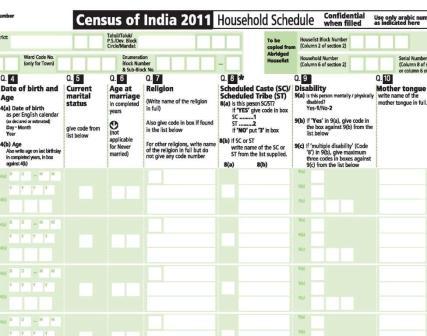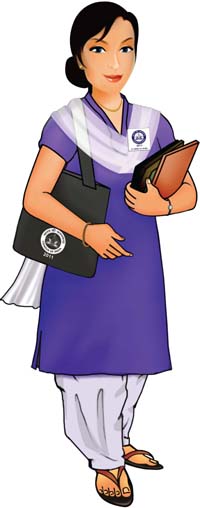Why Did It Take 4 Years to Prepare for the 2011 Census of India?
This is the second post in our Decoding Open Data series. The foundation of this series is our slideshare, which examines the open dataset and provides key insights and analytics about the 2011 Census of India.
These blog posts provide context around the Census – how it was created, how it is conducted, and how it has developed over time.
————————–
Four years before the 2011 Census of India was to start, census and government officials were already preparing for the massive undertaking.
Building the Census Questionnaire
The National Institute of Design, Ahmedabad, was selected to design the paper census forms, used to collect data from each person in the country. The National Institute of Design aimed to create a design that was easy to use, aesthetically interesting, and easy to scan. To accomplish this, they added several new features like a bar code, a unique number on each form, and various gradients of color to improve readability.
The government also spent time determining which questions would appear on the census forms and how those questions would be written. Census officials first created a list of questions, then they tested those questions in the field to see how clear and effective they were.
Updating Census Maps
A key part of Census preparation was the creation of an updated, accurate set of maps. During the Census, officials use maps to divide geographic areas among different enumerators. Accurate maps are essential for ensuring that every village, town, and household is covered without omission or duplication.
To create an accurate set of maps, the Maps Division of the National Government updated the jurisdictional boundaries of all administrative units, from states and UTs to the smallest towns and villages. This mapping was done digitally using GIS software.
In addition, the Maps Division used satellite imagery to create detailed digital maps of 33 major cities. These maps show the layout of buildings, houses, other structures, important landmarks and road networks at the ward level.
Training Census Enumerators
A critical part of Census preparation is training the enumerators who go door to door collecting data on each household in the country. If these enumerators are not trained properly on the content and methodology of the Census, the quality of the data will suffer.
Enumerators are public employees who are tasked with carrying out the survey, which happens outside of their current job. Most enumerators are teachers, though anganwadi sevikas, ration officers, and other government employees were also assigned census duty. Some schools were closed for up to 20 days while their teachers were on census duty.
The training for these enumerators used a four-tier hierarchy. At the country level, there were 90 master trainers, who conducted training for 725 Master Trainer Facilitators at the state level. The Master Training Facilitators in turn trained 54,000 Master Trainers at the district level. It was then the responsibility of each Master Trainer to train 50 enumerators at the grassroots level. This process resulted in over 21 lakh enumerators being trained on for the 2011 Census.
Enumerator training used three main tools:
- Instruction Manual: this document was given directly to enumerators during their training. It had been improved from 2001 by adding more illustrations and examples.
- Training Guides: these guides were meant for trainers. They provided minute-to-minute agendas of how training should be conducted at each stage, including tips on communication and building rapport with the people being trained.
- E-learning modules: videos were created on important census concepts, where animated characters representing enumerators and respondents showed how to ask census questions.
Raising Awareness about the Census of India
The Census of India is highly dependent on publicity — if people don’t know about the Census and its importance, they are less likely to answer questions when an enumerator appears at their door. For this reason, the government hired advertising agencies to plan and conduct an elaborate publicity campaign across various forms of mass media.
Traditional Media
 The foundation of the Census’ publicity was traditional media — newspaper, radio, and television ads. The campaign targeted rural areas by using 12 local languages, folk music, wall paintings and dance.
The foundation of the Census’ publicity was traditional media — newspaper, radio, and television ads. The campaign targeted rural areas by using 12 local languages, folk music, wall paintings and dance.
In addition, Sachin Tendulkar and Priyanka Chopra signed on to publicize the Census through television ads
Actors from a popular TV serial, Tarak Mehta Ka Ulta Chasma, also produced an television ad about the 2011 Census.
These ads encouraged people to fully cooperate with Census enumerators and answer all questions correctly. In particular, Chopra urged women to talk about the work they do, which often is not fully accounted for in demographic data.
Digital Media
In addition to television and print ads, the Census was heavily publicized on Facebook and Twitter.
In the first week of February 2011, the government created Census 2011 accounts on both Facebook and Twitter. These accounts made regular posts about different aspects of the Census and encouraged people to participate fully. The accounts also publicized preliminary results from the data, including interesting facts or statistics.
The Facebook account currently has 87.4k likes, and the Twitter account @IndiaCensus2011 has 24.9k followers.
Mascot
 On February 2, 2011, the Union Home Minister P. Chidambaram unveiled the mascot for Census 2011 — an animated woman with a black Census bag and a stack of files. She is meant to represent the thousands of enumerators conducting the Census.
On February 2, 2011, the Union Home Minister P. Chidambaram unveiled the mascot for Census 2011 — an animated woman with a black Census bag and a stack of files. She is meant to represent the thousands of enumerators conducting the Census.
Census officials chose a female mascot as a tribute to the growing number of female enumerators. In addition, the female mascot is meant to enhance the status of women enumerators, who often face more difficulties and less respect than male enumerators.
The mascot does not have a name or location, since Census officials wanted it to represent all religions and regions of India equally. The mascot’s slogan is “Our Census, Our Future”.
The mascot was originally only designed for the enumerator training manuals, but it was later incorporated into all advertisements when people indicated that the Census needed an identity or face.
Census in School
To sensitize students to the Census, the government introduced a program called “Census in School”. The program distributed School Kits to over 35,000 schools, about 60 to 80 schools in each of the 593 districts in India.
The School Kit contained a letter from the Census Commissioner, India to the principal of the school requesting him or her to inform the students about the importance of the Census. The School Kits also included special lessons for the students of Classes VI, VII and VIII.
These School Kits were used as part of Census Week, one week in January that was designated for developing awareness about the 2011 Census.
Curious how effective this preparation was? Part 3 of this blog series — Results of the 2011 Census of India — will be posted soon!
Want to learn more about the Census? See Part 1 of this series for a history of how the Census was created and how it has changed over time.
Want to dig into the Census data yourself? Sign up to get an early access pass for our excel plugin, where you can access open data directly from Excel. No more finding and downloading CSV files.
The post Why Did It Take 4 Years to Prepare for the 2011 Census of India? appeared first on SocialCops Blog.
